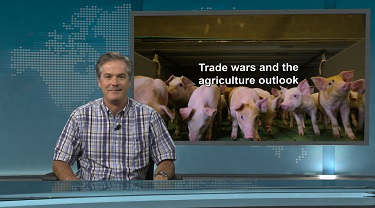Food is again at the forefront of a fracas in global trade. China reacted three weeks ago to U.S. tariff escalation by slapping an outright ban on imports of American food products. Both the U.S. action and the Chinese reaction exacerbated global trade jitters, which, if anything, have gotten worse in the ensuing days and weeks. It has also upended the agri-food industry and led to a lot of speculation about possible fallout. What are the expected outcomes of this latest development and are there opportunities for Canadian food exporters?
Discussions of trade in foodstuffs usually begin with market-entry issues. The industry is plagued the world over with overt protectionism, more subtle non-tariff barriers to trade, regulations, packaging and preparation requirements, phytosanitary restrictions…the list is endless. But once in a market, it’s no small thing to exit. Food is, in great part, a short shelf-life industry, and in a just-in-time world, reliability is critical: slip up on a key shipment and you’re done. On the other hand, fulfil all the requirements consistently, and the co-dependence becomes very strong—disrupting such relationships is far easier said than done. This applies to both domestic and external suppliers, although the former are almost always more important.
These issues are arguably much more acute in China. It has the largest number of mouths on the planet to feed. Although its population isn’t growing, China’s people are getting richer by the tens of millions every year, boosting the intensity and quality of their food consumption. According to the Food and Agriculture Organization of the United Nations, China’s net dependence on the rest of the world for food imports is rising dramatically. And to complicate things, China’s particularly intense appetite for pork is being compromised this year by African swine flu, which has decimated its extensive domestic swine herds.
China is a heavy net importer of food, notching a US$41-billion deficit with the rest of the world in 2017. The U.S. is China’s largest foreign supplier, at US$26 billion in 2017, with Brazil a very close second. The next group, which includes Canada, drop sharply in value to the US$6- to 7-billion range. Clearly, the loss of U.S. imports would be next to impossible to replace overnight without a massive dislocation of food trade flows. Even so, China’s focus on food security will ensure rapid remedial action.
At the same time, China is America’s top food export customer, with Canada a close second. Other large U.S. customers are Mexico and Japan. Despite its greater diversification of food exports, the U.S.’s loss of food product sales to China is a severe blow, and it’s almost equally hard to imagine how the U.S. could find replacement markets overnight.
An additional complication is the tangle of foreign ownership. To ensure a steady global supply, Chinese firms have invested in food production facilities offshore. It has sizable investments in the U.S., entities that now fall under the new import ban. Clearly, these and their supply chains are at risk. In a world of globally integrated business, a trade action that is meant to punish another country easily becomes a self-inflicted wound.
There are no easy solutions. The U.S. is the world’s largest food exporter and China is its largest importer. Of the largest food exporters, many—especially the European countries—import almost as much as they ship out; there are very few heavy net exporters the size of Brazil. Most others, like Canada, are much smaller players. To quote Gilbert and Sullivan, “a nice dilemma we have here, that calls for all our wit.” Resolution implies a monstrous and unnecessary game of whack-a-mole.
However unsettling, current conditions do raise opportunities. Even the threat of food supply disruption provokes an instant, urgent need for diversification of supply. Panicked buyers seek and form new relationships. Suppliers who respond quickly and reliably face new, permanent and lucrative opportunities. Among other things, this would likely require sharply higher production.
The bottom line?
China’s ban on imports of U.S. food products, however fleeting, will have temporary and permanent effects on the marketplace. For Canadian food exporters, this is a moment to pay rapt attention to every development, and leverage every opportunity.
This commentary is presented for informational purposes only. It’s not intended to be a comprehensive or detailed statement on any subject and no representations or warranties, express or implied, are made as to its accuracy, timeliness or completeness. Nothing in this commentary is intended to provide financial, legal, accounting or tax advice nor should it be relied upon. EDC nor the author is liable whatsoever for any loss or damage caused by, or resulting from, any use of or any inaccuracies, errors or omissions in the information provided.





